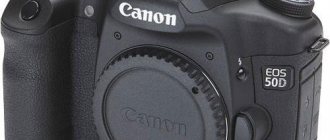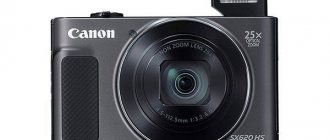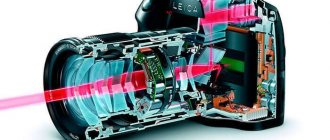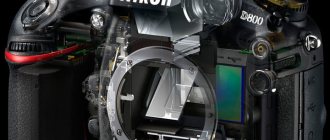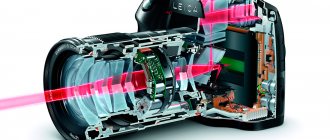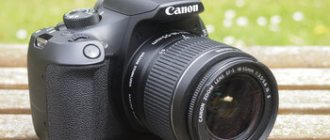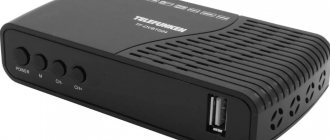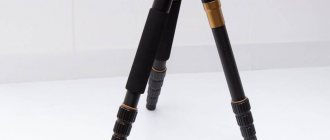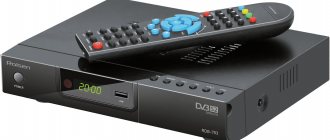Today, no one will be surprised by a new SLR camera in the hands of an inexperienced student. It has become very prestigious to have a DSLR instead of a regular digital camera. Naturally, most often in the selection process no one cares about the main parameters of the camera, the main thing is the price tag and the word SLR. Although when the need arises to purchase not for status, but for maximum functionality. The question arises: “how to choose a SLR camera?”
There are many resources on the Internet with specialized information for professional photographers, which the average user cannot understand. Therefore, the article contains all the important concepts for beginners and explains them in simple language. Well, for greater usefulness, a review of the best camera models in the category.
What is a SLR camera
To clarify, you can look into any electronic encyclopedia and find an incomprehensible set of words instead of a definition.
Translated into Russian, a DSLR can be called any representative of this segment of technology that has a mirror in its device.
Using a lens system, light penetrates the body of the camera, is reflected from the mirror prism and hits the matrix, which transmits the image to the viewfinder.
Here another unfamiliar word appears: matrix. In essence, the matrix is a semiconductor wafer on which there are ultra-sensitive cells - pixels. They take photos by capturing light waves and converting them into electromagnetic waves.
In ordinary cameras there is no mirror, as well as a lens system, that is, the light falls directly on a specially modified matrix. Naturally, when electronics are used, the image is delayed and distorted.
SLR cameras are divided into amateur and professional.
SLR camera matrix
DSLRs are divided into two types: with a full-frame matrix and cropped . Full frame - have a sensor equivalent to 35mm film with dimensions of 36 x 24 mm. This matrix is installed in the best and most expensive cameras. It has minimal noise when setting high ISO values, better picture detail and full frame coverage. The smaller the matrix, the potentially worse the image quality and the greater the depth of field of the image. Cropped sensors are slightly smaller than a full-frame sensor or, in other words, a “trimmed sensor” with dimensions of 22.3 x 14.9 mm - they have less frame coverage (that is, to shoot what a full-frame camera can capture, you need to step back almost twice further), noise is much more pronounced at high ISO values (which helps to shoot when there is a lack of natural light), the quality is slightly worse, but they are 5 times cheaper than full-frame DSLRs. You can read more about the comparison of these types of sensors in the article “why a full-frame sensor is better than a cropped one.”
The harsh reality is that for many, the megapixel count is an important factor when choosing a DSLR camera - all of which is influenced by marketers. This is not entirely correct. To print a photo on A3 size paper, 10 megapixels are enough. The bottom line is that with the same matrix size and an increase in the number of megapixels, their size decreases, because more must be placed on the same matrix size. And with smaller pixel sizes, high ISO images become noisier. Therefore, you should not chase the number of megapixels. You can read more about ISO in the article “what is ISO and why is it needed?” Cameras with a full-frame matrix are chosen mainly by professional photographers who are engaged in commercial photography, shoot for glossy magazines, as they fully reveal all the capabilities of the camera when working with high-quality and expensive lenses. Well, cropped matrices are several times cheaper, so they are available to mere mortals. For example, the cheapest full-frame DSLR that I know costs $2000, and the cropped one costs $400, do you feel the difference? So, we have looked at the main criterion for choosing a professional SLR camera, which directly affects the quality of the photo. All other criteria relate more to ergonomics and ease of use.
Pros of a DSLR camera
If you ask a professional photographer about the advantages of a DSLR camera, he will begin to list countless specific characteristics of the camera.
The main advantages are: long battery life without recharging, fast operating speed, clarity of images, natural (without distortion) colors, excellent performance in any lighting.
All of the above advantages are determined by the design features of the camera and depend on the performance of the filling.
How to choose the right DSLR cameras
The question is interesting, to answer it you need to find out something else: what characteristics are worth paying attention to.
The first thing you need to decide is whether the lens is important to you in the photography process or whether you can get by with the camera itself.
Glass (lens) can be different. Prices also vary. At the beginning of mastering professional photography, it is recommended to limit yourself to a basic lens or kit, as it is also called. Maybe all the delights of the camera will seem unnecessary to you and further advancement is useless. Then additional expenses can also be eliminated.
When purchasing an accessory, a beginner should look at the focal length of the mirror. 18-55 is considered optimal. It will help you photograph both distant and close objects without any problems.
Another tip: if you really want to make your life easier, then buy a DSLR without glass. And after mastering the basic principles, you will already select the appropriate equipment.
The next important parameter in a DSLR camera is the matrix. At its core, it is considered an analogue of a frame on film and is responsible for the quality of the image.
When choosing a camera, the size and resolution of the matrix are important. The optimal resolution is 10-12 megapixels. No more manufacturers needing to say nothing. But it is better to choose a larger size. The larger the area, the more beautiful the pictures will be.
In addition, you need to take into account the ISO level (sensitivity) of the matrix, that is, the level of light perception. A higher rate will make it possible to shoot in poorly lit rooms and outdoors at night.
Currently, two types of matrices are used: CDD (charge-coupled device) and CMOS (complementary metal-oxide-conductor).
The first ones are taken for quality: the level of “noise” is very low. The latter benefit in price, although the quality suffers from this: there is a lot of interference. But they think quickly and consume less battery.
Another gobbledygook in the description of the DSLR can be the speed and stabilization.
For the DSLR brother of the digital camera, stabilization helps eliminate blurry shooting, even when the photographer’s hands are shaking. The only disadvantage of such a system is that the photo is not very sharp. A similar characteristic can be found in both the camera and the lens. It will be terribly useful for beginners.
Its superior speed gives the DSLR the ability to capture action shots, whether it's a pet or a competition.
Based on the above characteristics, you can choose the one that is most convenient for you.
Of course, all this is just a theory that needs to be applied in practice, that is, in comparing real cameras. The only thing that still needs to be remembered is the desire parameters. For example, the maximum resolution in all flagship models is much higher than optimal. The reason is simple, marketing: 40 megapixels sounds better than 12.
Characteristics of a SLR camera
Megapixels
To understand the importance of megapixels, we'll look at what a pixel actually is. In photographic terms, a pixel is synonymous with an "image element", which is made up of microscopic squares that number in the millions in this day and age. Each of these squares records a specific value for light, tint, and shadow, ultimately forming a full-size image that replicates the scene the photographer hopes to capture. Each megapixel of a camera represents 1,000,000 pixels, so it's no surprise that the higher the number of megapixels, the greater the camera's image potential.
Megapixels aren't the be-all and end-all of a digital camera - the integrity of other components like the sensor, lens and ISO capabilities can lead to very different results. Take a mobile phone camera system for example - although the latest smart devices boast megapixel counts that put most entry-level DSLRs to shame, the photography will pale in comparison to a professionally oriented setup. In truth, a DSLR can contain a larger, more technologically advanced image sensor, while a mobile device cannot.
All things considered (and with the same sensor size threshold), megapixels are important for two reasons: cropping and print size. A camera with a higher resolution and megapixel count can handle cropping and resizing at a much higher level, which is why professional photographers—those who shoot for magazines, billboards, and large-format print—prefer high-resolution cameras. As a rule, modern cameras use a megapixel threshold of no lower than 12 and no higher than 36 (although there are exceptions). Interestingly, the importance of high megapixel resolution platforms has been hotly debated in the photography community, arguing that excessive values beyond the 16-20 range offer no real advantage over their smaller counterparts. For beginners, it's important to remember that any number of megapixels above this number is just icing on the cake. Now that we understand what megapixels are, let's talk about why the sensor is one of the most important aspects of a camera.
Sensors
To effectively resolve the tension between megapixels and sensor size, we'll break it down with one easy-to-remember rule: the larger the sensor, the more information the camera will have to render the image. An DSLR's sensor acts as a petri dish for light-sensitive spots called photosites, allowing integral data to be collected that can be used by the camera to develop the image.
A larger sensor offers more storage space for photosites, while a smaller sensor does not. Keep this in mind when you're shopping for a DSLR with more megapixels - if the camera doesn't have the right sensor to take advantage of them, it might be time to upgrade to a better platform. As a rule of thumb, most entry/consumer level cameras use three main sensor sizes: a Micro Four Thirds 4/3 sensor, which uses a 17.30 x 13.00 mm plane, an APS-C (or cropped) sensor, which uses a 23 plane .60 x 15.60 mm, and a full frame sensor that uses a 36.00 x 24.00 mm plane. While it may seem like a full-frame sensor stands head and shoulders above other offerings,
When purchasing your first DSLR camera, it is important to remember that the crop factor of an ASP-C sensor is approximately 1.5 to 1.6 times that of a full frame camera, meaning that a 50mm full frame lens will be the same as an 80mm lens when used with ASP -C platform.
ISO performance
Although the International Organization for Standardization is simply the body that determines the sensitivity ratings of camera sensors, a camera's ISO is often referred to as "light sensitivity." A camera's ISO rating (and performance) is recognized as one of the three pillars of photography, with the other two being embodied in the form of shutter speed and aperture. The exposure of an image is controlled through these three pillars, and often photographers must rely on the camera's ISO capabilities to create artificial light, especially in dark or underexposed areas.
Depending on the quality of your device's light sensitivity, this can mean the difference between running at a much higher threshold (>32000+ ISO) and degrading images at much lower levels (<16000 ISO). There's no getting away from this aspect of photography, and unfortunately, the cheaper your system, the less dynamic it will be when it comes to ISO performance. Large sensor sizes, increased sensitivity to light, and noise control are all factors you should consider when looking for the best camera system, but that doesn't mean you can't find the perfect sweet spot when looking for your first camera.
Lenses
Last but not least, we'll talk about the capabilities of the lens. The world of photography is full of myths, and so the importance of a well-designed lens is often overlooked in favor of larger megapixels and larger sensors. While these two variables are undoubtedly important to an entry-level camera's performance, one of the best investments you can make is building a healthy lens ecosystem. Camera bodies are constantly being updated with new technologies, becoming more skillful every day, but a well-made lens is timeless. Although lens manufacturers today can offer modern improvements over vintage manual focus lenses (in the areas of incredibly sharp autofocus capabilities, better color control, etc.).
A good lens can make a mediocre camera look professional, but a bad lens can make a professional camera look amateurish. Good lenses are an investment that provide photographers with an adaptable “tool” that can color the world in many different ways. To understand the best aspects of a lens, we'll start with the basics. As photographers grow and prosper, they better understand what to look for when it comes to focal lengths, aperture values, and quality control, with the help of each lens designer. We briefly touched on the different mount ecosystems in our article “What is a DSLR?” section, now it's time to go down the rabbit hole a little more.
Since we're focusing on DSLRs, we'll touch on the offerings presented by Nikon and Canon, two of the leading DSLR manufacturers in the industry. As stated earlier, Nikon uses the F mount system, while Canon prefers its own EF mount. Canon's EF USM line is the brand's flagship offering with the trademark "red ring" around the outer body, while Nikon's flagship, the AF-S NIKKOR line, features the iconic gold ring. These lenses are easy to identify, full frame compatible and feature the highest quality glass element on the front of the cylinder.
At the other end of the spectrum, we have Canon's EF STM line and Nikon's DX offerings, which are considered entry-level lenses for each brand. While these lenses sacrifice low-light AF performance, quiet AF motors, high-quality glass, and reliable durable construction, they are ideal for the budding photographer who wants to break into the color capturing field.
Essentially, a versatile photographer will want a well-chosen selection of adaptable lenses, from a wide-angle 24mm (or 35mm) lens to a 50mm lens for mid-range photography and over 85mm for any subject at a distance. Lenses for beginners are a cost-effective way to get into the world of photography, but if you're willing to invest the time (and money), it's always best to do your research, study photographers you find inspiring, and see how they use their own kit. A good lens is always more expensive than a mediocre camera body, so here's a wise old adage to live by: A good lens can make a mediocre camera look professional, but a bad lens can make a professional camera look amateur.
Now that we've established some of the most important things to look for in an entry-level camera, let's take a look at two entry-level offerings from Nikon and Canon.
Rating of the best SLR cameras
Our experts have compiled a list of the best SLR cameras, the list of the best is presented below:
- Nikkon D5300;
- Canon EOS 600D;
- Sony Alpha ILCA-A77 II;
- Nikon D3200;
- Canon EOS 70D.
Below we briefly describe each model.
Mirror camera Nikon D5300 kit 18-55
Despite being budget-friendly, the camera's parameters are impressive. A focal length of 18-55 will help you play with zooming in and out without any problems. DSLR stabilizer will add clarity. Speed 5 fps. in the first couple of minutes it will not allow you to miss the most interesting moments. And the ability to connect to wi-fi simplifies the process of moving work results. According to professionals, the model is the best in its category.
Canon EOS 600D Kit 18-135
Owners claim excellent photographs obtained as a result of use. Matrix: 18 megapixels, focal length: 18-135, shooting frequency 3.7 frames per second - all this will be useful to fans of miniature photography. In addition, the device is considered an analogue of the Nikon D5300 kit 18-55 only from Cannon.
Sony Alpha ILCA-A77 II Kit 18-135
This model is more suitable for experienced users, as it has a rather large set of specific functions: with a focal length like the previous analogue, this device can offer 79 different positions in zoom mode, as well as a shooting speed of up to 12 frames per second.
Nikon D3200
Another camera for beginners can please buyers not only with its simple interface, but also with an affordable price. 24 megapixel expansion, 11 zoom points, the ability to take 4 pictures per second. The choice of mirror model for a novice amateur is obvious.
Canon EOS 70D
The Japanese assembly clearly adds credibility to this DSLR. For connoisseurs of movement, there is a sport mode here. A 20.2 megapixel matrix and 19 focusing points provide almost unlimited shooting possibilities.
Finally, I would like to say that no matter what camera you choose, a SLR or a simple one, the main thing in the process is to focus only on yourself. It’s better to buy something simpler, but functional and comfortable. No matter how cool the camera is, without the necessary controls the photos will not be of the highest quality.
Nikon vs Canon
Nikon D3500
The D3500 is currently the reigning champion of Nikon's entry-level camera lineup, boasting a 24.2-megapixel DX CMOS sensor, EXPEED 4 image processor and native ISO 100-25,600. Perhaps the biggest differentiator when it comes to the dominant offering Nikon is the fact that the D3500 has eliminated an optical low-pass filter, which means the image is "smoothed" (or softened) to cope with moire (a wave-like phenomenon that occurs when repeating details of a subject exceed the sensor's allowable resolution). In turn, image sharpness is adjusted so that the sensor can better cope with the repetitive nature of the subject. In practice, this softens the image, leaving users with a less sharp photo, which is often significantly less desirable.
The D3500's elimination of the low-pass filter ensures that the camera has been built to cope with the repetitive nature of certain textures, producing sharper images than its competitors. To enhance this, the D3500 uses a 23.5 x 15.6mm APS-C sensor, meaning it maintains a 1.5-1.6x crop value, as well as a 3.0-inch 921k LCD monitor .Points, 1080P video recording at up to 60fps and an 11-point autofocus system for maximum accuracy.
Sensor: 24.2 MP DX format CMOS Processor: EXPEED 4 Image processor ISO: Standard ISO 100-25600; Shooting at 5 fps Monitor size: 3.0-inch 921k dot LCD Video capabilities: Full HD 1080p video recording at 60 fps Autofocus system: Multi-CAM 1000 Autofocus system WiFi / Bluetooth points SnapBridge, Bluetooth connectivity
Canon EOS Rebel T7
Canon's EOS Rebel is one of the most respected cameras in the industry, and their updated T7 model is currently the best offering in their entry-level camera lineup. Equipped with a 24.1MP APS-C CMOS sensor and renowned DIGIC 4+ image processor, the T7 boasts a 9-point AF system with cross-type center point technology to capture subjects with ease. However, its ISO 100-6400 rating is significantly lower than the Nikon D3500, and with a sensor size of 22.3 x 14.9mm it also lags behind its competitor's 23.5 x 15.6mm crop sensor. It can record Full HD 1080P video at 30fps and even has a 3.0-inch 920k-dot LCD monitor, which isn't enough to knock the D3500 off its throne. A camera backpack might be reason enough to stick with the company's EF ecosystem.
Sensor: 24.1 MP APS-C CMOS Sensor Processor: DIGIC 4+ Image processing ISO: ISO 100-6400, up to 3 fps Monitor size when shooting : 3.0″ 920k dot LCD Video capabilities : Full HD 1080p video recording at 30fps Auto Focus system: 9-point AF with cross-type center point WiFi / Bluetooth: Built-in WiFi with NFC
If you want to buy an entry-level SLR camera, it is better to do this using the link in the trusted M.video store.
Share with friends
